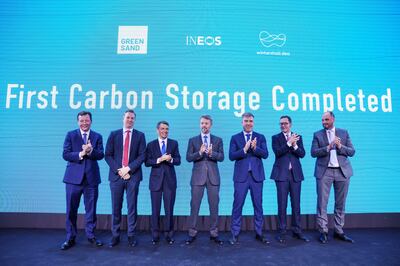European companies have injected carbon dioxide below Denmark’s seabed for the first time in an ambitious project that could become a key component in the fight against climate change.
Denmark pushed the start button on Project Greensand to pump CO2 to beneath a North Sea oilfield where it will be stored permanently, safely away from the atmosphere.
Carbon, capture and storage is a potentially critical technology for eliminating CO2 from industrial processes that are difficult or currently impossible to decarbonise through electrification.
If the project is successful, the group of companies — which includes the UK’s Ineos and Germany’s Wintershall Dea — plan to scale it up to store emissions captured at sites across Europe.
Executives warned that Europe risks losing a race with the US on important emissions-cutting technology.
Project Greensand is the world’s first cross-border carbon storage project.
“There is no chance in hell that we will meet the global climate targets without CO2 storage. It’s a tool that we need,” said Denmark climate and energy minister Lars Aagaard.
Denmark's Crown Prince Frederik gave the symbolic order to begin pumping CO2 into the depleted reservoir of the Nini West oilfield, 50 years after his father Prince Henrik celebrated the start of oil and gas exploration off the coast.

“It gives me great pleasure today to be able to reverse the traffic in the pipes and send CO2 back into the Danish underground to the benefit of the climate for Denmark, for Europe, but also for the planet,” said Prince Frederik.
Initially, gas will be shipped in liquid form from an Ineos plant in Belgium, but the plan is to bring in CO2 from Denmark and other European countries later on.
After the pilot stage, 1.5 million metric tonnes of the greenhouse gas will be buried in a sandstone reservoir at 1.8km below the seabed each year, eventually rising to 8 million tonnes per year by 2030.
“To keep global temperatures below 1.5°C, we need to remove carbon on top of our efforts to reduce emissions,” European Commission President Ursula von der Leyen said.
The EU needs to capture and store about 300 million tonnes of CO2 annually by 2050 if it wants to be climate neutral, she added.
Some experts have warned that carbon capture and storage is still an unproven technology and relying on it could undermine efforts to decarbonise the energy sector.
But without it, European industries face rising carbon costs alongside higher energy prices.
That threatens the competitiveness of industries that could move to the US, where energy is cheaper and President Joe Biden’s climate bill provides generous subsidies for carbon capture and storage.
“There’s a lot more to be done inside Europe,” said Brian Gilvary, chairman of Ineos Energy. “The United States, now with the Inflation Reduction Act, is going to suck in investment into CCS at scale.”
Mario Mehren, chief executive of Wintershall Dea, added: “Europe needs to definitely speed up.”
While carbon capture has been used extensively by the oil and gas industry to enhance production, storing CO2 below the sea has only been tried in a handful of small pilots and is still relatively untested.







